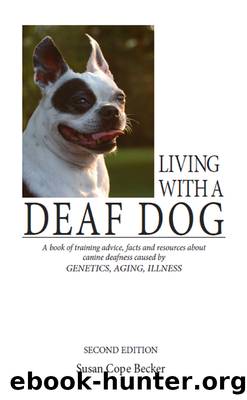Living With A Deaf Dog by Susan Cope Becker

Author:Susan Cope Becker
Language: eng
Format: epub
Tags: ebook
Publisher: Dogwise Publishing
Published: 2017-10-06T00:00:00+00:00
⢠Young dogs should only be crated for short periods of time. They can be confined for approximately the number of hours equal to their age in months plus one (that is a 3 month old puppy should be able to be in his crate for 4 hours).
⢠Never crate your (adult) dog for more than 6-8 hours per day. Your dog should not be spending his life in a crate.
⢠Never let your dog out of the crate if he is barking or whining. Wait until he is quiet, even if itâs only a few seconds, before you release him.
⢠Donât leave food in the crate with the dog as this will encourage him to eliminate in the crate. You can use a hanging water bottle, like those used on rabbit cages, to provide water for your dog.
⢠Teach children and other family members to respect your dogâs crate. He is not to be disturbed or harassed while heâs in it.
⢠Do not use the dogâs crate as punishment.
⢠Search âcrate trainingâ on Youtube for videos on this topic.
Will your dog need to be in his crate for the rest of his life? Absolutely not. A crate is a safe place for a puppy, a safer way to travel, and a big help in house training, but once your dog has matured (generally, not before at least one year of age), he can begin to stay loose in the house when no one is home (most dogs can be loose at night in the bedroom as soon as they are reliable house trained, at about 6 months). Some owners leave their dogâs crate for their dog to use as a den. Lots of dogs grow to love their crates.
DROP
When you want your dog to drop a toy or another object, use this hand sign for drop: clench your fist with finger-side facing the ground. Open your fingers as if you are dropping an object.
⢠Have a treat in the hand that you will use to take the toy. Sign drop with the other hand. Your dog will have to drop the toy to take the treat. Give the reward and clap.
⢠Using two toys, throw one and when the dog comes back throw the other toy which makes him drop the first and go after the second.
FENCES
A must (if you can afford it) that makes the deaf dogâs life a lot more joyful and safe. Freedom within a fence is an important element to having happy, well adjusted dogs whether they are hearing or deaf. Deaf dogs living in rural settings are lucky indeed.
GROWLING
Growling is a defensive behavior that signals that a dog feels threatened and anxious. This piece of advice should help.
⢠Lyndsay Patten, founder of the Deaf Dog Newsletter shared his experience when his dog growled at him: âCairo growled at me because he was afraid I would take his chew toy away. The solution is to reduce the anxiety and so avoid the defensive behavior (growling). With many dogs, giving a correction will have the opposite effect, reinforcing the anxiety.
Download
This site does not store any files on its server. We only index and link to content provided by other sites. Please contact the content providers to delete copyright contents if any and email us, we'll remove relevant links or contents immediately.
| Breeds | Care & Health |
| Training |
Finding Gobi by Dion Leonard(2717)
Grumpy Cat by Grumpy Cat(2583)
A New Earth: Awakening to Your Life's Purpose by Eckhart Tolle(2444)
The Silkworm by Robert Galbraith(2405)
Tippi by Tippi Hedren(2148)
End of Days by Sylvia Browne(2083)
Total Cat Mojo by Jackson Galaxy(1941)
Backyard Chickens Beyond the Basics by Pam Freeman(1873)
The Animals Among Us by John Bradshaw(1778)
The Ultimate Pet Health Guide by Gary Richter(1704)
All Things Bright and Beautiful by James Herriot(1645)
Vet in Harness by James Herriot(1637)
Doggy Desserts: 125 Homemade Treats for Happy, Healthy Dogs by Cheryl Gianfrancesco(1622)
Cesar's Way by Cesar Millan(1612)
Dog Years by Mark Doty(1596)
Chicken Soup for the Ocean Lover's Soul by Jack Canfield(1575)
Dog Training 101 by Kyra Sundance(1529)
Walking with Peety by Eric O'Grey(1527)
Animal Speak by Ted Andrews(1416)
